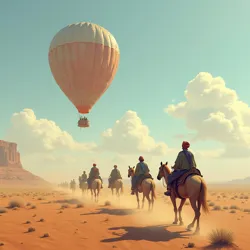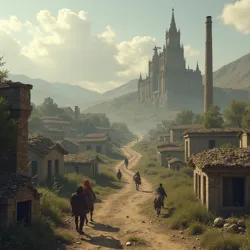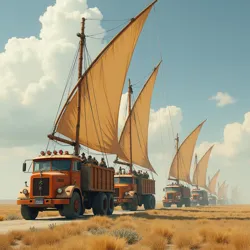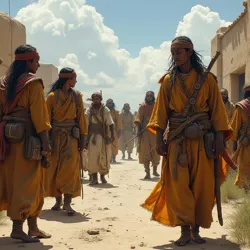Dustwind Nomads

Mobile communities traverse the vast, arid expanses of the former Great Plains after the Great Desiccation, adapting to scarce resources.
Mobile communities
Former Great Plains/Midwest
Great Desiccation
Migratory
Sky-Sails
Environmental hazards, conflict
Family groups/clans
Trade and conflict
The *Dustwind Nomads* are a collective term used to describe various distinct, mobile communities that traverse the vast, arid expanses of the former Great Plains and Midwest regions of the United States following the ecological and societal collapse known as the Great Desiccation. Referenced in accounts of the Humoral Hike pilgrimage, these groups represent a significant adaptation to the transformed landscape, having abandoned settled life in favor of a migratory existence dictated by the scarce resources and harsh environmental conditions of the post-Desiccation era. Their way of life is inextricably linked to the relentless dust storms and the unpredictable availability of water and sustenance in the parched heartland of the continent.
Emerging from the remnants of agricultural and small-town populations who could no longer sustain themselves in fixed locations, the Dustwind Nomads have developed unique survival strategies, social structures, and technologies tailored to their mobile existence. They navigate treacherous territories, scavenge for usable materials from the ruins of the Old World, and rely on a deep, albeit harsh, understanding of their new environment. While often viewed with suspicion or fear by more settled communities, the nomads possess invaluable knowledge of the vast, dangerous regions they inhabit and represent a resilient form of human adaptation in the face of unprecedented environmental catastrophe. Their migrations are not random wanderings but are typically guided by ancestral knowledge, the search for ephemeral water sources, and the avoidance of the most dangerous Mutated megafauna or highly toxic zones.
Origins and Emergence
The genesis of the Dustwind Nomads is directly rooted in the catastrophic environmental shifts brought about by the Great Desiccation in the late 21st century. As detailed in accounts of this period, the prolonged megadrought, combined with extensive resource depletion and environmental degradation, rendered vast swathes of the North American continent uninhabitable for settled populations. The regions that would become the primary domain of the Dustwind Nomads – the former agricultural heartlands of the Great Plains and parts of the Midwest – were particularly devastated. Once-fertile soil turned to dust, rivers and aquifers dried up, and the infrastructure supporting large, fixed communities collapsed.
 Ruins of former agricultural towns and infrastructure after environmental collapse forced populations into nomadic survival.
Ruins of former agricultural towns and infrastructure after environmental collapse forced populations into nomadic survival.The societal fragmentation that followed the Great Desiccation saw the breakdown of centralized governance, economic systems, and transportation networks. For millions, remaining in their ancestral homes became impossible. Facing starvation, dehydration, and the constant threat of environmental hazards and social unrest, many were forced to leave. While some attempted to migrate to more hospitable regions like the coastal areas or the relatively protected Telurian Enclaves, others found themselves trapped in the interior, too far or too ill-equipped to reach distant sanctuaries. These displaced populations, often comprised of multiple families or even remnants of entire small towns, began to move, desperately searching for areas where survival was still possible.
The Collapse of Settled Life
Prior to the Great Desiccation, the regions now traversed by the Dustwind Nomads were characterized by extensive agriculture, supported by complex irrigation systems and stable weather patterns. The collapse of these systems was swift and brutal. The persistent drought killed crops, livestock perished, and the wells that supplied communities ran dry. The economic foundations of these areas, heavily reliant on farming, evaporated, leading to widespread poverty and famine. As infrastructure failed, transportation and communication became unreliable, further isolating communities and preventing effective external aid or organized relocation efforts.
The breakdown of law and order exacerbated the crisis. Without functional governments or law enforcement, communities became vulnerable to opportunistic raiders and internal conflicts over dwindling resources. The social fabric, strained by desperation and loss, began to unravel. For many, the only remaining option was to gather whatever resources they could carry – often salvaged vehicles, basic tools, and what little food and water they could find – and move in search of better conditions, however temporary they might be. This initial forced migration laid the groundwork for the nomadic lifestyle that would come to define these groups.
Adaptation to the Dust Bowl
The harsh environmental conditions of the post-Desiccation interior, particularly the formation of vast dust bowls, necessitated radical adaptations for survival. The relentless winds, carrying abrasive dust and pollutants, made permanent structures vulnerable and agriculture nearly impossible. Water became the single most critical resource, its availability dictating movement patterns. Those who survived learned to read the subtle signs of the landscape – the direction of the wind, the health of sparse vegetation, the presence of certain insects or animals – to locate temporary oases or predict impending dust storms.
Over time, these desperate migrants coalesced into more organized groups, sharing knowledge and resources for collective survival. They developed specialized skills in scavenging, navigation, and adapting existing technology for mobile use. The constant threat of the environment and other hostile groups fostered a strong sense of group loyalty and self-reliance. The nomadic lifestyle, initially a necessity born of catastrophe, gradually solidified into a distinct cultural identity, centered around movement, resilience, and a deep, often fatalistic, understanding of the unforgiving land. The name "Dustwind Nomads" reflects this intrinsic connection to the dominant environmental feature of their world – the omnipresent dust carried by the wind.
Lifestyle and Culture
The lifestyle of the Dustwind Nomads is fundamentally shaped by their continuous movement across the desolate landscape. Unlike historical nomadic groups who often followed predictable seasonal patterns or migratory animal herds, the Dustwind Nomads' movements are primarily dictated by the unpredictable availability of water, the location of viable scavenging sites, and the need to avoid environmental hazards like Radiation hotspots or concentrations of mutated megafauna. Their culture is one of resilience, resourcefulness, and a strong emphasis on collective survival.
 A long convoy of repurposed vehicles linked together, pulled across the desolate plains by large fabric sails harnessing the wind.
A long convoy of repurposed vehicles linked together, pulled across the desolate plains by large fabric sails harnessing the wind.Their mobile settlements, often referred to as "caravans" or "trains," consist of repurposed vehicles – trucks, buses, even heavy machinery salvaged from the ruins – modified to serve as homes, workshops, and storage. These vehicles are often linked together, forming long, serpentine convoys that move slowly across the plains, pulled by powerful engines or, increasingly, by innovative wind-powered systems like Sky-Sails. Life within the caravan is communal; tasks like scouting, scavenging, maintenance, and defense are shared among the members.
Nomadic Movements and Routes
The routes taken by the Dustwind Nomads are fluid and often change based on immediate conditions. However, certain general patterns have emerged over generations. Many groups follow the dry beds of former rivers, hoping to find pockets of residual moisture or access to shallow aquifers. Others traverse the remnants of old highways, using them as easier, though often more dangerous, paths through the rough terrain. Knowledge of these routes, including the locations of hidden caches of water, relatively safe scavenging sites, and areas to avoid, is passed down through oral tradition and is highly valued.
Their movements are frequently interrupted by dust storms, forcing the caravan to halt and hunker down, sometimes for days. Finding water is a constant struggle, leading them to employ various techniques such as digging shallow wells in promising locations, collecting condensation from metal surfaces at dawn, and even distilling moisture from certain hardy desert plants. Food sources are equally precarious, relying on opportunistic hunting of smaller, non-mutated wildlife, gathering of drought-resistant edible plants, and scavenging preserved goods from abandoned settlements.
Social Organization and Leadership
Dustwind Nomad society is typically organized into extended family groups or clans, which collectively form a caravan. Leadership structures vary but are often based on a combination of age, experience, and proven ability. Elders, particularly those with deep knowledge of the land and survival skills, hold significant respect. Skilled individuals, such as mechanics capable of keeping the vehicles running, scouts who find resources and safe paths, and those adept at scavenging or defense, also hold positions of influence.
Decision-making is often communal, with important choices regarding direction, resource allocation, and interactions with outsiders discussed among the caravan members. While there may be a designated leader or council, their authority is often based on consensus and the willingness of the group to follow. This decentralized structure allows for flexibility and rapid adaptation to changing circumstances, essential for survival in their volatile environment. Loyalty to the caravan and its members is paramount, as individual survival is nearly impossible outside the group.
Technology and Survival Skills
The technology of the Dustwind Nomads is a fascinating blend of salvaged pre-Desiccation engineering and ingenious adaptation. Their most critical assets are their vehicles, which are meticulously maintained and modified. Engines are kept running using scavenged fuel or alternative power sources like biomass converters. Structures are built onto truck beds and trailers, creating mobile homes and workshops. Solar panels, scavenged from old installations, are often used to power basic electronics or charge batteries, though their effectiveness is often hampered by dust.
A key innovation for many nomad groups is the use of Sky-Sails. These are large, durable fabric sails, often made from repurposed materials like tent canvas, conveyor belts, or even sections of old buildings, rigged to tall masts on their lead vehicles. When the wind is favorable, these sails are deployed, harnessing the pervasive dustwinds to pull the entire caravan across the flat plains, conserving precious fuel. This technology, while simple in concept, requires significant skill in construction, rigging, and navigation to effectively utilize the often-turbulent winds.
Beyond technology, the nomads possess a wealth of practical survival skills. They are expert scavengers, capable of identifying useful materials in the most desolate ruins. They understand rudimentary mechanics, allowing them to repair and maintain their vehicles and equipment. They are skilled trackers and hunters, able to pursue the elusive wildlife of the post-Desiccation plains. They have also developed methods for purifying contaminated water and identifying edible plants and fungi in a landscape where much of the vegetation is toxic or mutated. Their knowledge of the land rivals that of the Telurian people, albeit focused on survival in a ruined environment rather than harmonious coexistence.
Interaction with Other Groups
The relationship between the Dustwind Nomads and other inhabitants of the Post-Desiccation United States is complex and varied, ranging from wary coexistence and mutually beneficial trade to outright hostility and conflict. Their mobile nature and resourcefulness make them both potential allies and targets in the fragmented landscape.
 An exchange of salvaged goods, resources, and information between Dustwind Nomads and other groups like the Humoral Hike.
An exchange of salvaged goods, resources, and information between Dustwind Nomads and other groups like the Humoral Hike.Settled communities, often clinging to precarious existence in fortified enclaves or areas with relatively stable resources, view the nomads with a mixture of apprehension and curiosity. Nomads are sometimes seen as dangerous outsiders, capable of raiding settlements for supplies. However, they are also recognized as possessing unique knowledge of the vast, dangerous territories between settlements and may be sought out for information, trade, or even as guides.
Other nomadic groups, such as the more religiously oriented Ironclad Pilgrims, may share similar challenges but differ in their motivations and practices. Encounters between different nomad groups can lead to conflict over resources or territory, but also to alliances, intermarriage, and the exchange of knowledge and goods. The Ironclad Pilgrims, with their focus on salvaging and repurposing pre-Desiccation technology, often trade advanced components or functional devices to the Dustwind Nomads in exchange for hard-to-find raw materials or information about the location of promising ruins.
Trade and Barter
Trade is a vital component of the Dustwind Nomads' survival strategy and their interactions with other groups. Lacking the capacity for large-scale production or agriculture, they rely on scavenging and their mobility to acquire goods. They often trade salvaged materials – metal, plastic, electronics components, functioning pre-Desiccation tools, and even rare finds like pre-packaged food or clean water filters – with settled communities or other travelers.
In return, they seek resources they cannot easily obtain on the move, such as manufactured goods, medical supplies (though Telurian remedies or those of the Humoral Hike are often preferred when available), seeds for planting in temporary camps, or specialized knowledge. Their caravans often act as informal mobile markets, facilitating the exchange of goods and information across the vast distances of the post-Desiccation landscape. The value of items is determined by scarcity and utility, with clean water and fuel often being the most highly prized commodities.
Conflict and Defense
Life on the move in the Post-Desiccation world is inherently dangerous, and the Dustwind Nomads are frequently involved in conflicts. They face threats from opportunistic raiders who prey on vulnerable travelers, rival nomad groups competing for resources, and dangerous mutated megafauna that roam the plains. As a result, the nomads are often well-armed and organized for defense.
Their caravans are designed with defense in mind, often forming defensive circles when stationary. Many nomads are skilled in the use of salvaged firearms, crossbows, and improvised weapons. Korthos, the Draakar bodyguard accompanying Maerion, represents the kind of formidable warrior necessary for survival in this environment, and some nomad groups employ individuals with similar martial prowess, though few can match Draakar strength. Their scouts are also crucial for early warning, allowing the caravan to avoid threats or prepare for confrontation. While they prefer to avoid conflict, the Dustwind Nomads are fierce defenders of their homes and families.
Encounters with the Humoral Hike
Accounts of the Humoral Hike, the pilgrimage of Maerion and Korthos across the post-Desiccation United States, frequently mention encounters with various Dustwind Nomad groups. For the nomads, who often lack access to reliable medical care, the arrival of Maerion, the Telurian shaman, represents a rare opportunity for healing. Maerion's knowledge of Visceral Harmony and his access to potent Telurian herbal remedies, such as Moonpetal and Sunstone Root, are invaluable in treating ailments common among the nomads, including dehydration, malnutrition, injuries sustained during scavenging or conflict, and the debilitating effects of Aegrotism, which is particularly prevalent in the environmentally degraded regions they inhabit.
These encounters are often characterized by initial caution on both sides. The nomads, wary of outsiders, observe Maerion and Korthos carefully. Korthos's imposing Draakar presence and martial readiness, while intended for protection, can initially appear threatening. However, Maerion's gentle demeanor, his willingness to offer healing without demanding payment (though the nomads often offer what they can in trade as a sign of respect), and the tangible results of his treatments typically build trust. Stories circulating among the nomads speak of the "Wandering Healers" or the "Star-Touched Shaman," figures of myth and hope who bring relief from suffering. These encounters not only provide medical aid but also offer a rare connection to the world beyond the endless dust and a reminder that compassion still exists amidst the hardship.
Beliefs and Folklore
The unique environment and challenging lifestyle of the Dustwind Nomads have given rise to a distinct body of beliefs, myths, and folklore. Their spiritual outlook is deeply intertwined with the natural forces they constantly face – the wind, the dust, the sun, and the scarce water. There is often a sense of reverence, fear, and resignation towards the transformed land, seen not just as a physical space but as a powerful, sometimes malevolent, entity.
The wind, the ubiquitous force that shapes their world and powers their Sky-Sails, features prominently in their beliefs. It is often personified as a powerful spirit, capable of both bringing destructive dust storms and guiding the caravans to safety or resources. Some groups perform rituals to appease the wind spirit or seek its favor for their journeys. The dust itself is often seen as the physical manifestation of the land's suffering or anger, a constant reminder of the catastrophe that reshaped their world.
The Spirit of the Dust
Many nomad groups speak of the "Spirit of the Dust," a pervasive, unseen force that permeates the air and the land. This spirit is often depicted as ancient and indifferent, a residue of the old world's collapse. It is blamed for the dust storms, the scarcity of water, and the general hardship of their lives. However, some interpretations also see the Spirit of the Dust as a test of resilience, a force that purifies and strengthens those who can endure its trials.
Folklore includes cautionary tales about venturing into the deepest, most toxic parts of the dust bowls, where the Spirit is said to be strongest and most dangerous. There are also myths about finding hidden oases or areas untouched by the Desiccation, places where the Spirit of the Dust has no power, though such places are often depicted as mythical or exceedingly difficult to find. These beliefs provide a framework for understanding their harsh reality and the forces that govern their existence.
An excerpt from a collected piece of Dustwind Nomad oral tradition, transcribed by a traveler who spent time with a caravan near the ruins of what was once Kansas City, speaks to this relationship with the environment:
"The Dust remembers the green times, the flowing waters. It remembers the tearing of the soil, the greed that drank the wells dry. The Wind carries its memory, whispers it in our ears as we travel. We are children of the Dust, born of its anger, shaped by its breath. We do not fight the Wind; we ride it. We do not fear the Dust; we understand its sorrow. For in understanding, there is survival. In movement, there is life."
Tales of the Old World
Stories and legends of the "Old World" – the time before the Great Desiccation – are also a significant part of Dustwind Nomad folklore. These tales, often fragmented and distorted over generations, speak of abundant water, green fields, towering cities, and technologies that seem miraculous in the present day. These stories serve as both a reminder of what was lost and a source of hope, fueling dreams of finding remnants of the Old World that might ease their struggles.
However, the tales also often carry warnings about the excesses and mistakes of the Old World that led to the Desiccation. Stories of pollution, waste, and disregard for the natural world serve as cautionary examples, reinforcing the nomads' pragmatic approach to resource use and their deep, albeit forced, connection to the environment. The ruins they scavenge are not just sources of materials but also physical artifacts of these legends, tangible proof of a world that is now gone but not entirely forgotten.
Challenges and Future
The Dustwind Nomads face a relentless array of challenges that constantly threaten their survival. The environment itself remains their most formidable adversary. The unpredictable nature of dust storms, the scarcity of clean water and food, and the presence of toxic zones and dangerous mutated megafauna make every day a struggle. Aegrotism, the wasting sickness linked to environmental toxicity, is a constant threat, weakening individuals and entire caravans.
Beyond environmental hazards, they face the persistent danger of conflict with other groups, particularly raiders who see their caravans as tempting targets for plunder. Maintaining their aging vehicles and technology requires constant effort and ingenuity, as spare parts and fuel are difficult to acquire. The nomadic lifestyle, while necessary, is physically demanding and offers little in the way of long-term security or comfort.
Environmental Threats
The environmental threats faced by the Dustwind Nomads are pervasive. Dust storms can cause respiratory illnesses, damage equipment, and disorient travelers. Finding uncontaminated water is a daily challenge, as many surface sources are polluted or contain harmful bacteria. The land itself can be dangerous, with hidden radiation hotspots, unstable ground, and areas where toxic chemicals have concentrated. Mutated megafauna, often large, aggressive, and unpredictable, pose a significant threat to both the caravan and individual scouts or hunting parties. Survival requires constant vigilance and a deep knowledge of how to mitigate these dangers.
Sustaining the Nomadic Way
Sustaining the nomadic way of life requires a delicate balance of resource management, social cohesion, and adaptability. The success of a caravan depends on its ability to find enough resources to survive and keep moving. This necessitates efficient scavenging, careful rationing, and the ability to make the most of limited supplies. Maintaining social harmony within the caravan is crucial, as internal disputes can weaken the group and make it vulnerable. Leadership must be effective, and all members must contribute to the collective effort.
The future of the Dustwind Nomads is uncertain. Their existence is a precarious one, constantly on the edge of survival. However, their resilience and adaptability, honed over generations in the crucible of the post-Desiccation world, offer a glimmer of hope. As long as the dustwinds blow and there are resources to be found, these mobile communities will likely continue to traverse the desolate plains, a testament to the enduring human capacity to survive and forge a new way of life, even in the ruins of the old. Their journeys, though often difficult and dangerous, represent a vital thread in the fragmented tapestry of the post-Desiccation United States, connecting distant ruins and carrying the stories and skills necessary for a potential future recovery.